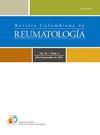Potenciales biomarcadores presentes en orina de pacientes con lupus eritematoso sistémico: estudio exploratorio en pacientes colombianos
Q3 Health Professions
引用次数: 0
Abstract
Objective
To describe the urinary levels of molecules related to removing apoptotic cells and triggering inflammation, as well as cytokines involved in Colombian patients with systemic lupus erythematosus without and with lupus nephritis compared to healthy controls.
Materials and methods
Urine samples were taken from three groups of patients: healthy controls (n = 7), patients with systemic lupus erythematosus without lupus nephritis (n = 7), and patients with lupus and lupus nephritis (n = 4). The urine sample was collected and concentrated by ultrafiltration. A western blot evaluated HMGB1, Histone H3, Calreticulin (CRT), Annexin A1 and CD46, CX3CL1 by ELISA and cytokines such as IL-8, IL-6, IL-12p70, TNF-α, and IL-1β by flow cytometry.
Results
Histone H3 was detected in two patients, one with systemic lupus erythematosus without lupus nephritis and one with systemic lupus erythematosus and lupus nephritis. The detected band suggests a post-translational modification. There were no differences between the levels of HMGB1 and CX3CL1 in the study groups. CD46, Annexin A1, and CRT were not detected in our samples. When evaluating cytokines in urine, an increase in IL-8 was observed in the group of patients with systemic lupus erythematosus without nephritis compared to controls. For IL-6, an increase was found among patients without lupus nephritis when compared with patients with lupus nephritis. No differences were found between the urinary levels of the other cytokines evaluated (IL-12p70, TNF-α, IL-1β, and IL-10).
Conclusion
Urinary histone H3 and IL-8 levels may be interesting molecules to be evaluated in more patients with systemic lupus erythematosus, while HMGB1 and CX3CL1 are not useful. Further evaluation of patients is required to confirm these findings.
系统性红斑狼疮患者尿液中的潜在生物标志物:对哥伦比亚患者的探索性研究
目的探讨哥伦比亚系统性红斑狼疮患者与健康对照组相比,尿中与清除凋亡细胞和触发炎症相关的分子水平以及与狼疮肾炎相关的细胞因子水平。材料与方法选取健康对照(n = 7)、系统性红斑狼疮合并狼疮肾炎患者(n = 7)、狼疮合并狼疮肾炎患者(n = 4)三组患者进行尿液采集,并进行超滤浓缩。western blot检测HMGB1、组蛋白H3、钙网蛋白(CRT)、膜联蛋白A1、CD46、CX3CL1, ELISA检测细胞因子IL-8、IL-6、IL-12p70、TNF-α、IL-1β。结果2例系统性红斑狼疮合并狼疮肾炎和2例系统性红斑狼疮合并狼疮肾炎均检测到H3。检测到的条带表明翻译后修饰。各研究组HMGB1和CX3CL1水平无差异。我们的样本中未检测到CD46、Annexin A1和CRT。当评估尿液中的细胞因子时,与对照组相比,在无肾炎的系统性红斑狼疮患者组中观察到IL-8的增加。与狼疮肾炎患者相比,非狼疮肾炎患者IL-6升高。尿中其他细胞因子(IL-12p70、TNF-α、IL-1β和IL-10)的水平没有差异。结论尿组蛋白H3和IL-8水平在系统性红斑狼疮患者中可能是值得关注的分子,而HMGB1和CX3CL1在系统性红斑狼疮患者中可能是无用的。需要对患者进行进一步评估以证实这些发现。
本文章由计算机程序翻译,如有差异,请以英文原文为准。
求助全文
约1分钟内获得全文
求助全文
来源期刊

Revista Colombiana de Reumatologia
Medicine-Rheumatology
CiteScore
0.80
自引率
0.00%
发文量
92
期刊介绍:
The Colombian Journal of Rheumatology (Revista Colombiana de Reumatología) is the official organ of the Colombian Association of Rheumatology (Asociación Colombiana de Reumatología) and the Central American, Caribbean and Andean Association of Rheumatology (Asociación Centroamericana Caribe Andina de Reumatología) - ACCA. It was created in December 1993 with the purpose of disseminating scientific information derived from primary and secondary research and presenting cases coming from the practice of Rheumatology in Latin America. Since its foundation, the Journal has been characterized by its plurality with subjects of all rheumatic and osteomuscular pathologies, in the form of original articles, historical articles, economic evaluations, and articles of reflection and education in Medicine. It covers an extensive area of topics ranging from the broad spectrum of the clinical aspects of rheumatology and related areas in autoimmunity (both in pediatric and adult pathologies), to aspects of basic sciences. It is an academic tool for the different members of the academic and scientific community at their different levels of training, from undergraduate to post-doctoral degrees, managing to integrate all actors inter and trans disciplinarily. It is intended for rheumatologists, general internists, specialists in related areas, and general practitioners in the country and abroad. It has become an important space in the work of all rheumatologists from Central and South America.
 求助内容:
求助内容: 应助结果提醒方式:
应助结果提醒方式:


